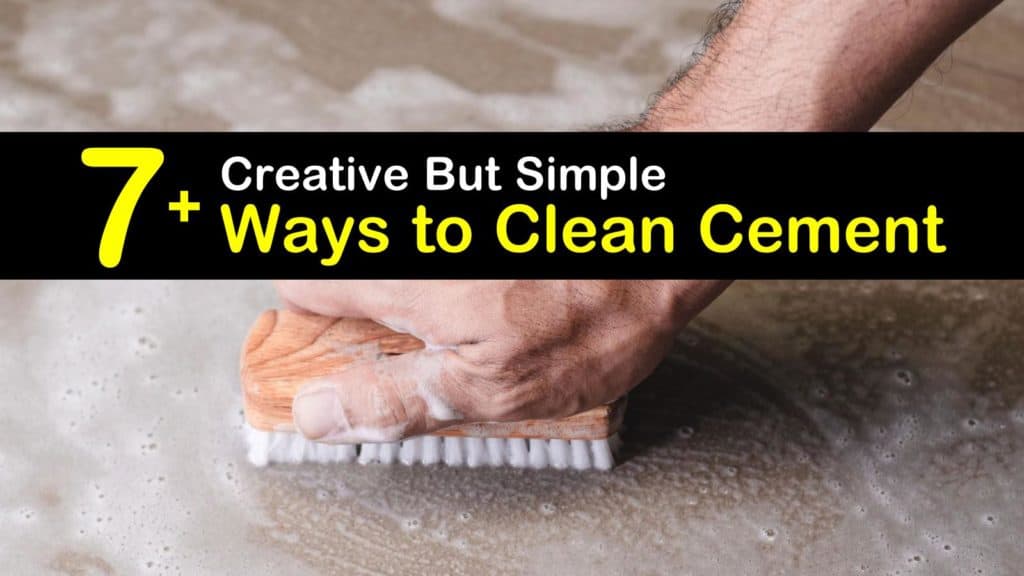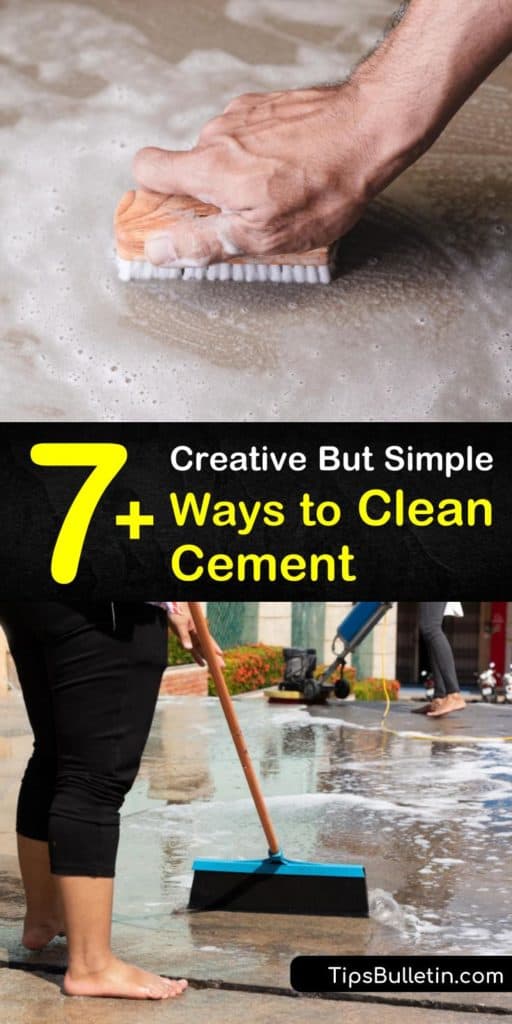Cement is one of the sturdiest, most durable building blocks capable of withstanding the test of time. As a result, it often appears in the foundations of homes and even as exterior walls. To keep your home dirt-free and well-maintained, knowing the best procedures for how to clean cement is imperative.
Cement cleaning also improves the condition of your home and reduces the effects of structural damage caused by weathering from the elements. Cleaning cement floors doesn’t always start with a home improvement makeover.
Whether cleaning concrete outdoors or indoors, it requires regular care that should take place at least once a week. While a deep washing of the floors or exterior walls is not required as often, keeping the material free of dirt and debris in between these cleanings increases the longevity of the blocks.

Try These Fantastic Ways to Clean Cement
In this article, we’ve put together the best ways to clean cement for use at all stages of the cleaning process.
Despite their durability, concrete floors consist of a porous material that makes them highly susceptible to things like mold and mildew if not appropriately treated. If the cement is outside, you will need to learn how to clean moss off concrete or other organic things that grow on walls or floors.
Their makeup is also why you should steer clear of certain chemicals, like ammonia and bleach, when you clean up your floors. There are plenty of other options to choose from that result in less damage to floors and surrounding plants outdoors.
Clear the Area of Dirt and Debris
Sweeping the cement surface is one of the most critical steps in the cleaning process. Not only should this be carried out at least once a week, but it also provides a blank slate to work on before spreading any cleaning products.
If you’re cleaning a basement or garage floor, use a push broom to rid the floor of any litter and debris. If sweeping away dirt from the side of a wall, lay a tarp at the base to collect leaves or items that fall to the ground.
Cleaning Cement Floors with Soap
For a simple concrete cleaner, a little bit of soap and hot water goes a long way. Soap is a powerful natural degreaser, quickly lifting away stains caused by oily residue and grime.

Adding in another phenomenal cleaning agent like baking soda enhances the solution by allowing it to absorb mildew-causing bacteria. This combination is especially beneficial for concrete porches and outside walls.
For cleaning a cement patio, your garage floor, or any other concrete surface, combine the ingredients in a large bucket, then spread over the concrete using either a push broom or a power washer.
Let the formula soak into the concrete to tackle stains and grime for approximately 30 minutes before scrubbing it with a stiff brush.
After the area is thoroughly washed, rinse the area with clean water. While a pressure washer is not required to keep the concrete clean, it does make rinsing away chemicals from the material much easier.
Treat Concrete Surface with Vinegar
In addition to everyday cleaning products like baking soda, vinegar is an excellent way to disinfect areas of your home. When using vinegar to clean concrete, the household staple removes bacteria, mold, and even reduces the appearance of stains.
In garages, it is particularly helpful for eliminating challenging grease stains. It’s also an excellent way to get rid of unpleasant odors at the same time.
When cleaning cement floors with a pressure washer, make sure to wear plastic goggles to protect your face. Even though the vinegar is a natural way to clean floors and walls, the force of the water stream may cause dirt and debris to launch back into your eyes and face.
If the concrete surface you’re cleaning is incredibly dirty and needs a little more love and attention than usual, use full-strength vinegar instead of the diluted version.
While you can clean cement with vinegar, you can also use vinegar as one of the ways to get concrete out of clothes if you poured concrete and got a little on your favorite shirt and jeans. Let the concrete dry on your clothes, pick off the chunks, and apply vinegar and water. Let it sit and scrub gently. Rinse well and launder as usual.
Create a Poultice to Remove Oil Stains
Common concrete stains that arise on your floors include those caused by oil and grease. While vinegar takes care of most of these issues, some stains may call for a stricter tactic. One stain remover option involves creating a poultice from two different materials.
Creating a poultice is not limited to the ingredients listed above. However, they must meet a specific set of criteria. The first half of the treatment must be a solvent, such as acetone or mineral spirits.
Some also use trisodium phosphate (TSP) dissolved in water as a solvent for this combination. The second half requires a grainy, absorbent material like baking soda or even sawdust. When combined, these two ingredients form a type of putty that lifts away tough stains on unfinished cement.
The poultice possesses a consistency similar to peanut butter and is slathered over the stain to soak overnight. After it dries, sweep the plaster away by using a stiff bristle brush.
Use Oxalic Acid for Rust Removal
Rust stains occur more frequently on concrete than you think. The porous material is the perfect place for metallic pieces to embed themselves within the stone.
Concrete is exposed to metal by way of any number of avenues: tools, metal bristles on brushes, and car parts. Even fertilizers and plant products in gardens contain traces of metals that get trapped within nearby concrete over time.
When these areas get wet, either by rain or watering plants, rust slowly develops, leaving behind an unsightly rust stain on concrete that you may not know how to remove.
One of the best ways to treat rust is by using oxalic acid. This ingredient is found in foods like potatoes, though more highly concentrated forms exist in commercial cleaning products.
Following along with the instructions provided by the manufacturer, use the oxalic acid to remove rust stains from cement both indoors and outdoors. Make sure you wear the appropriate coverage to protect your hands and face.
Remove Mold from Cement with OxiClean
Bleach is a standard ally to turn to for help to combat issues like mold. A safer variation of chlorine bleach is to use an oxygen bleach like OxiClean instead. Oxygen bleach works just as well to get rid of mold and mildew and is much more environmentally friendly than traditional bleach.
There are two ways to use this method to clean a concrete driveway or garage floor. The first is through an all-over approach, which requires about a gallon worth of diluted OxiClean in water.
If you are just treating a small stain, or controlled area of mold, then adding the mixture to a spray bottle also works well. In both cases, use a scrub brush to work the chemicals into the concrete and rinse thoroughly when finished.
How to Clean Cement using Muriatic Acid
Outside of the need for clean concrete, some floors also contain grout that requires a little cleaning from time to time. The grout collects challenging gunk and grime that often requires a potent cleaning agent to execute correctly.
Not all cement flooring uses tiles, though in both cases, the same chemical cleans both in a similar manner. Muriatic acid is a caustic material used to remove cement from tiles, as well as clean up stubborn rust and oil stains.
Using a cleaning agent as powerful as muriatic acid requires that you take an extra level of caution. Wear protective coverings and goggles, and only use this chemical in a well-ventilated area outside the home. Follow the manufacturer’s instructions on the muriatic acid for the best results.
Other Ways to Clean Cement
Making your floors resistant to stains in the future is almost as important as ridding them of the blemishes themselves. Adding a concrete sealer as a protective layer over the floor blocks out messes and spills that may cause not only discoloration but also mildew and mold.
Before adding the sealer, ensure the base is adequately cleaned using a simple method like dish soap and baking soda. Next, strip away any lingering pieces of sealer from the cement. The most potent chemical for this step would be muriatic acid.
The acid also fulfills the action that follows removing the sealer, which involves etching the cement to allow the paint to cling to it more smoothly. Afterward, paint a thin layer of sealer over the floor. Wait 24 hours for the sealer to dry before adding a second coat.
When ready, polish concrete floor as you see fit to develop a beautiful shine. Add the sealer every two to three years to keep the stone secure and protected.
With so many different ways to clean cement, the perfect technique is here for you. Even if you still aren’t sure which strategy to start with, select one based on the ingredients and equipment you already have handy. After that, you feel free to experiment with new elements on the list from time to time until you perfect your process.

If you found these concrete floor cleaning tips useful, then please remember to share everything you learned about how to clean cement with all the homeowners in your life on Facebook and Pinterest.